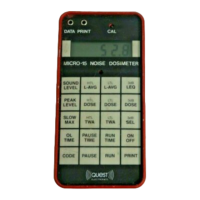Weighting Characteristics
The MICRO 15 has both "A" and "C'" weighting characteristics
as shown in Figure 3. For OSHA and most noise measurement requirements, the
"A" weighting should he used. The "A" weighting has a similar response to the
human ear. The "C" weighting is used for measuring noise reduction in hearing
protectors and other scien-ific purposes.
Microphone Characteristics
The microphone used on the MICRO-15 Dosimeter is a Model
1845 ceramic microphone designed tor use in sound level measuring
instruments. An integral FET amplifier and controlled acoustical construction
provide the transduction sensitivity level, frequency range, and flat frequency
response necessary for ANSI S1.4-1983 Type 2 sound level meter requirements.
Overall diameter is 8 mm Typical sensitivity is 70 dB below 1 volt per microbar
measured at 1 KHz, Figure 4 is a diagram of a typical microphone response .
Internal Electrical Noise
The internal electrical noise of the MICRO-15 is equivalent to an
acoustical level of approximately 40 dB. On the 5O-146 dB range the internal
noise has a negligible effect on the reading. On the 40-126 dB range the internal
noise determines the lowest reading of the meter.
Microcomputer Modes
The MICRO-15 is controlled by a MC146805 CMOS Microcomputer. The
MC146805, in addition to being a general purpose microprocessor, has32 input
output lines, 112 bytes of RAM, 2106 bytes of ROM, a counter, an interrupt, a
low power wait state, and a very low power stop state. The MICRO-15) operates
in one of the following six modes.
Reset Mode
The MICRO-15 enters the reset mode when the unit is reset or a battery is
connected. In this mode power is applied to the unit, all previous data is cleared,
the internal switches are read, the counter is cleared, the pause register is set,
four dashes are placed on the display, and the unit enters the wait mode.
Wait Mode
In this mode the microcomputer waits for an interrupt to occur. During the
wait mode it continues to gather data from the voltage to frequency converter.
Otherwise the microcomputer is in a low power state. When the 1/16 second
interrupt occurs, the unit enters the pause or run mode depending on the pause
register.
Pause Mode
In this mode the SLOW time constant sound level is computed and the
pause time is counted. Every second the keyboard is checked to see if any key is
pressed. If a key is pressed the computer enters the compute mode. Otherwise it
returns to the wait mode.

